Fair Work Action Plan 2022 and Anti-Racist Employment Strategy 2022: child rights and wellbeing impact assessment
Child rights and wellbeing impact assessment (CRWIA) of the Fair Work Action Plan 2022 and Anti-Racist Employment Strategy 2022.
4. Evidence and key issues
4.1 Population change
The latest estimate of the Scottish population is 5,479,900. The population has grown 0.25% since mid-2020, which is 0.18% lower than the average annual growth in the 5 years preceding the pandemic.
Contrary to previous years, population growth was recorded in many rural council areas while the population in the largest cities fell. For some rural regions, this year reversed a trend of population decline, such as Aberdeenshire and Argyll and Bute. While for other rural areas such as Highland and Perth and Kinross, the rate of steady growth increased. However, as some of this growth may be attributable to increased freedom of working environment related to the COVID pandemic, it is impossible to say if these trends will continue in future years.
Net migration was identified as the biggest driver of population change, with 27,800 more people moving into Scotland than leaving. This includes net international migration of +18,900 and 8,900 more people moving into Scotland from the UK than from Scotland to the UK.
While it is widely accepted that Scotland, like many European countries, has an ageing population, people under 19 still comprising 21% of the Scottish population in 2019 according to National Records of Scotland (NRS) data. NRS estimated in 2021 that 17% of the population were 15 and under which has decreased by 6% since 2000 but is broadly in line with the 16.1% of the population who were children under the age of 15 in the last Scottish Census data that is available, from 2011.
As such, children and young people make up a sizeable and significant portion of the Scottish population.
4.2 Labour market statistics
4.2.1 Employment and unemployment
Employment rates in Scotland have always fluctuated. As shown in Figure 4-1, a steep decline in employment was experienced between 2008-2012 in line with the recession of 2008/09, before rising again to its peak of 74.8% in 2019.[32] The employment rate then decreased to 73.2% in 2021,[33] however the latest quarterly employment rate estimates reveal that the employment rate has since increased to 76.6% in 2022 Q4.[34]
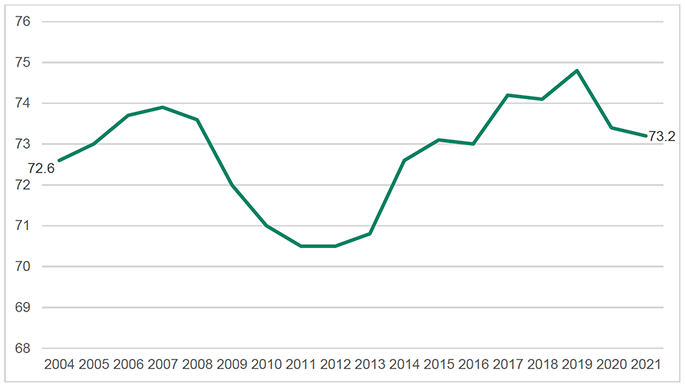
Source: Scottish Government (2021, 2022)
The Business Register and Employment Survey Data identifies the number of jobs by industry sector across Scotland. In 2021, 15.3% worked in the health sector, whilst 10.0% worked in retail, and 8.3% worked in education. Contrastingly, the sectors with the lowest levels of employment were property (employing 1.5% of the working population), motor trades (1.7%) and mining, quarrying, and utilities (2.4%).
Figure 4-2 reveals that the Full-time and Part-time employment rates for those aged 16-64 have remained relatively stable over time. However, the Part-time employment rate consistently sits lower than the Full-time employment rate, fluctuating between 24.6% in 2004 and 24.3% in 2021 compared to 75.4% and 75.5% respectively.[35]
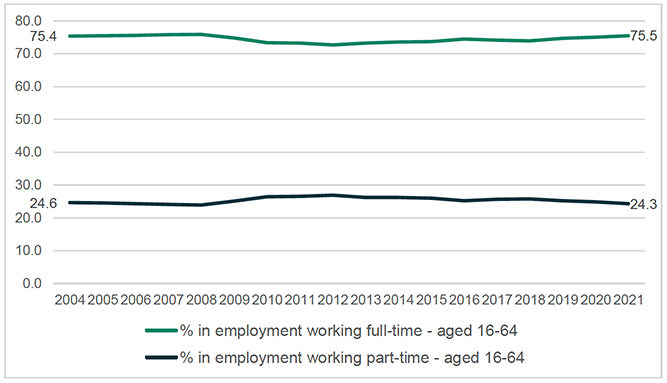
Source: Annual Population Survey, January to December data, ONS
The self-employment rate fluctuated between 2004 and 2021, reaching a peak in of 12.7% in 2016. In 2021, the self-employment rate was recorded at 11.0%.[36]
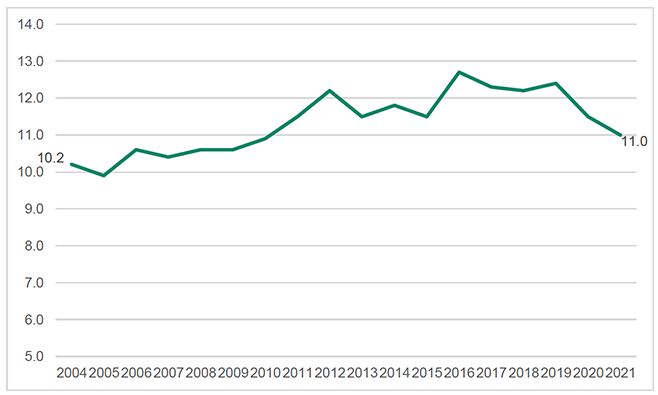
Source: Annual Population Survey, January to December data, ONS
Unemployment rate figures have fluctuated between 2004 and 2021. In 2008, the unemployment rate began to rise to a peak of 8.2% in 2011 before decreasing steadily until 2017. Between 2017-2021, the rate fluctuated annually reaching 3.9% in 2021.[37]
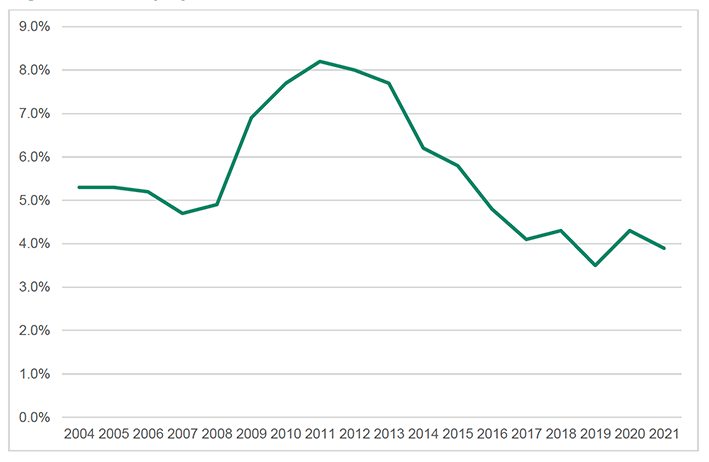
Source: Annual Population Survey, January to December data, ONS
4.2.2 Real Living Wage
The real Living Wage is an hourly rate of pay established by the Living Wage Foundation which employers can voluntarily commit to. It is £10.90 across the UK, and £11.95 in London for people aged 18 or over. Unlike the UK Government's minimum wage ('National Living Wage' for over 23s – £9.50), the real Living Wage is the only wage rate independently calculated based on living costs. It is a voluntary base rate for employers who wish to go beyond the government minimum to demonstrate that they value their lowest paid staff. Living Wage employers pay all their directly employed staff aged 18 and over – as well as in scope regular third-party contractors – at or above the real Living Wage.
At present, according to the Employer Directory in Scotland there are over 2,900 real Living Wage employers, with concentrations seen in large cities such as Edinburgh and Glasgow.[38]
Social Enterprise Scotland has demonstrated the potential outcomes of paying the real Living Wage:[39]
- Over 59,000 workers currently employed by over 2,900 Living Wage employers in Scotland will receive a welcome pay boost because of the new rate; and
- As a result of rate increase, a full-time worker on the real Living Wage will earn £1,950 a year more than their current pay.
Further research from the Smith Institute reports a potential relationship between paying the real Living Wage and increased productivity and motivation in the workplace. Increased wages are also likely to have a positive impact on health and well-being through enabling workers to meet every day needs and increase resilience against financial crises. Therefore, these impacts could be acutely felt across low paid sectors and low-income households.[40]
Figure 4-5 below reveals the percentage of employees (18+) earning at least the real Living Wage in Scotland between 2012-2022, across all employees, public sector employees, private sector employees and employees within not for profit or mutual organisations.[41]
Records for all employees (18+) reveal that 81.2% were paid at least the real Living Wage in 2012, which increased 2.0 percentage points to 83.2% by 2019.[42] In 2022, the percentage of employees who were paid the real Living Wage stood at 91.0%.
In 2012, 96.5% of public sector employees were paid at least the real Living Wage and increased 0.4 percentage points to 96.9% by 2019. An increase was also recorded for private sector employees, from 71.7% to 75.4% in 2019. While data for not-for-profit organisations is only available for 2015-2022 and records an increase from 85.2% in 2015 to 85.4% in 2019.
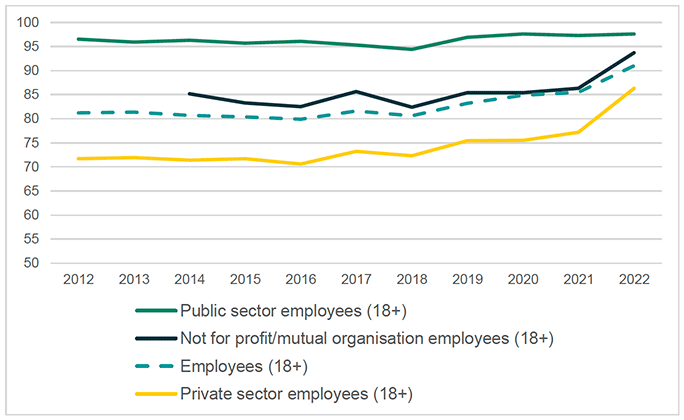
Source: Scottish Government, Annual Survey of Hours and Earnings (2022)
4.3 Child poverty
The latest records (2017-2020) estimate that 21% of children were living in relative poverty before housing costs and 24% after housing costs.[43] Following a steady decline between 1994-1997 and 2010-2013, child poverty rates have been rising again.
Figure 4-6 identifies priority groups for children which are known to have a greater risk of being in poverty. Most households with children experiencing poverty will belong to at least one of these groups.
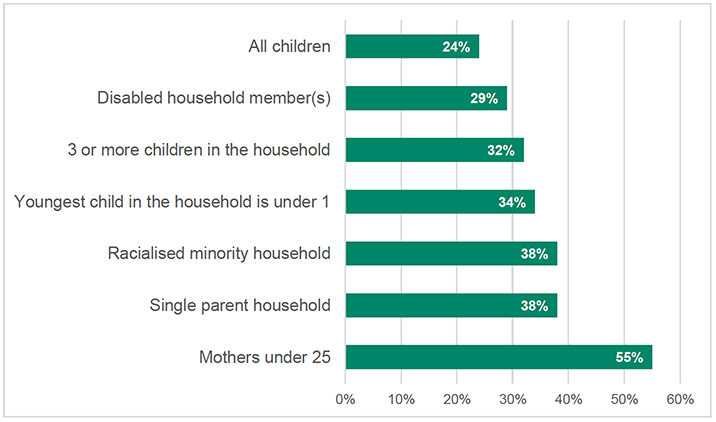
Source: Scottish Government (2021) Poverty and Income Inequality
Tackling child poverty is a Scottish Government priority with 24% of Scotland's children (240,000 children each year) living in relative poverty after housing costs in 2017-2020. Prior to the outbreak of COVID-19, it was predicted that if no further action were taken to tackle child poverty one in three children in Scotland would grow up in poverty by 2030, damaging society and the economy. The impact of COVID-19 on child poverty levels is still largely unknown, particularly the long-term effects on families and our economy, however we know that the impacts have been felt most acutely by the most disadvantaged in our society. Children in low-income households tend to experience a range of disadvantages including lower educational attainment and poorer health.
Poverty can have lasting impacts long into adulthood such as increased risk of homelessness, lower earning potential and greater likelihood of limiting illness. It is difficult to disentangle the effect of poverty from other factors associated with low income that may affect children's outcomes. However, the growing evidence in developed economies suggests that gaining additional income has positive causal effects on health, behavioural development and educational attainment for children in households at the lower end of income distribution.
In the Children's Parliament report 'What Kind of Scotland?', poverty is identified as the most important barrier to a good life. It affects children day to day, in terms of practical things like having enough food to eat and a house that is warm, but also because children may notice the stress money concerns cause the adults at home.
Through the Best Start, Bright Futures: Tackling Child Poverty Delivery Plan, the Scottish Government have recognised that children facing poverty are not a homogenous group and that intersectional identities and inequalities are present, in relation to sex, disability and ethnicity.
Contact
There is a problem
Thanks for your feedback